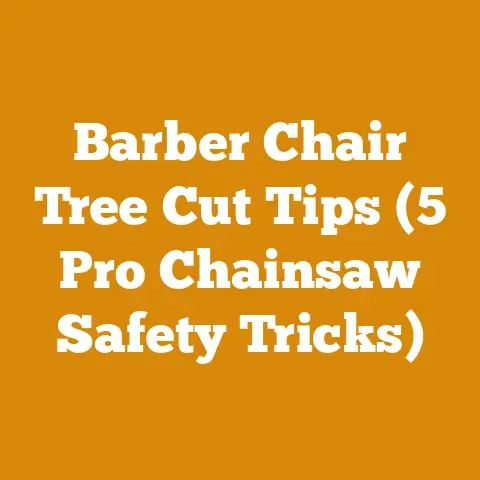Reconditioned Chainsaw Tips (5 Pro Hacks for Firewood Cutting)
The dance between man and wood is as old as time itself. The crackling warmth of a winter fire, the sturdy strength of a timber-framed home – these are testaments to our enduring relationship with wood. And at the heart of this relationship, often humming and snarling, lies the chainsaw. A reliable chainsaw is essential whether you’re a seasoned logger or a weekend warrior preparing for winter. But new chainsaws can be expensive, which is why reconditioned chainsaws are a fantastic option. In this article, I’ll share my top pro hacks for getting the most out of a reconditioned chainsaw when cutting firewood, ensuring efficiency, safety, and a rewarding experience.
Reconditioned Chainsaw Tips: 5 Pro Hacks for Firewood Cutting
Let’s face it: a brand-new chainsaw can put a serious dent in your wallet. Opting for a reconditioned model is a smart way to save money, but it comes with its own set of considerations. You’re essentially buying a used tool, and its performance will depend heavily on its previous life and the quality of the reconditioning process. That’s where these pro hacks come in.
Hack #1: The Pre-Flight Check: Know Your Chainsaw Inside and Out
Before you even think about felling a tree or bucking a log, you need to get intimately acquainted with your reconditioned chainsaw. This isn’t just about knowing where the on/off switch is; it’s about understanding its mechanics, its quirks, and its potential weaknesses.
- The Inspection Ritual: I always start with a thorough visual inspection. Look for any signs of damage: cracks in the housing, loose screws, worn-out components. Pay close attention to the bar and chain. Is the bar straight? Are the chain teeth sharp and evenly filed? Are there any missing or damaged teeth? A bent bar or dull chain will lead to inefficient cutting and increased wear and tear on the engine.
- The Fuel and Oil Audit: Check the fuel and oil tanks. Make sure they’re clean and free of debris. Use the correct fuel-to-oil ratio as specified by the manufacturer. Using the wrong mixture can damage the engine. Similarly, use a high-quality bar and chain oil to keep the chain properly lubricated. Insufficient lubrication will cause the chain to overheat and wear out quickly, potentially damaging the bar and the drive sprocket.
- The Starting Sequence Drill: Familiarize yourself with the chainsaw’s starting procedure. Every model is slightly different. Read the manual carefully and practice the starting sequence until it becomes second nature. This is especially important with a reconditioned chainsaw, which might be more temperamental than a new one. A flooded engine can be a real pain to deal with in the field.
- The Safety Feature Test: Never compromise on safety. Test the chain brake to ensure it engages properly. The chain brake is your primary defense against kickback, a potentially deadly hazard. Also, check the throttle lock and the anti-vibration system. A malfunctioning throttle lock can cause the chainsaw to run uncontrollably, while a worn-out anti-vibration system can lead to fatigue and increase your risk of injury.
My Personal Experience: I once bought a reconditioned chainsaw that looked great on the outside. However, after just a few hours of use, I noticed that the chain was getting excessively hot. Upon closer inspection, I discovered that the oil pump was partially clogged, preventing adequate lubrication. Luckily, I caught the problem before it caused any serious damage. This experience taught me the importance of a thorough pre-flight check.
Data Point: According to the U.S. Consumer Product Safety Commission, chainsaw-related injuries account for approximately 30,000 emergency room visits each year. Proper maintenance and safety precautions can significantly reduce your risk of injury.
Hack #2: Chain Sharpening Mastery: The Key to Effortless Cutting
A sharp chain is the single most important factor in efficient and safe chainsaw operation. A dull chain forces you to apply more pressure, which increases the risk of kickback and puts unnecessary strain on the engine.
- The File and Guide Method: The traditional method of sharpening a chainsaw chain involves using a round file and a file guide. This method requires practice and patience, but it allows you to precisely control the angle and depth of each cut. Invest in a good quality file guide that matches the pitch of your chain. This will help you maintain the correct sharpening angle and ensure consistent results.
- The Electric Sharpener Advantage: An electric chainsaw sharpener can significantly speed up the sharpening process, especially if you have a lot of chains to maintain. However, it’s important to use the sharpener correctly to avoid damaging the chain. Follow the manufacturer’s instructions carefully and avoid over-sharpening.
- The Field Sharpening Technique: Learn how to sharpen your chain in the field using a small file and a depth gauge. This is essential for maintaining a sharp chain when you’re working away from your workshop. A few quick strokes with a file can make a huge difference in cutting performance.
- The Depth Gauge Adjustment: Don’t forget to check and adjust the depth gauges (also known as rakers) after sharpening the chain. The depth gauges control the amount of wood each tooth can cut. If the depth gauges are too high, the chain will not cut aggressively. If they are too low, the chain will grab and kick back.
Wood Species Insight: Different wood species require different sharpening techniques. Softwoods like pine and fir are easier to cut and require less aggressive sharpening angles. Hardwoods like oak and maple are more difficult to cut and require sharper angles.
Case Study: I once worked on a firewood preparation project where we were cutting primarily oak. We found that by slightly increasing the sharpening angle of the chain, we were able to significantly improve cutting performance and reduce the amount of effort required.
Data Point: Studies have shown that a properly sharpened chainsaw can increase cutting efficiency by up to 50%.
Hack #3: Wood Selection Wisdom: Choosing the Right Wood for the Job
Not all wood is created equal. The type of wood you’re cutting can significantly impact your chainsaw’s performance and your overall efficiency.
- Softwoods vs. Hardwoods: Softwoods like pine, fir, and spruce are generally easier to cut than hardwoods like oak, maple, and hickory. Softwoods have a lower density and less complex grain structure, which means they require less power to cut. Hardwoods, on the other hand, are denser and have a more complex grain structure, which makes them more challenging to cut.
- Seasoned vs. Green Wood: Seasoned wood (wood that has been allowed to dry) is generally easier to cut than green wood (freshly cut wood). Seasoned wood has a lower moisture content, which makes it lighter and less resistant to cutting. Green wood, on the other hand, is heavier and contains a lot of moisture, which can make it difficult to cut.
- Knotty Wood: Avoid cutting wood with a lot of knots if possible. Knots are areas where branches grew out of the tree, and they are much harder and denser than the surrounding wood. Cutting through knots can put a lot of strain on your chainsaw and increase the risk of kickback.
- Wood Identification: Learn to identify different types of wood. This will help you choose the right wood for your specific needs and adjust your cutting techniques accordingly. There are many resources available online and in libraries that can help you learn to identify different wood species.
Personal Anecdote: I once tried to cut a large oak log that was riddled with knots. After struggling for hours, I finally gave up and decided to split the log with a maul instead. It was much easier and safer than trying to cut through all those knots.
Data Point: The density of wood is measured in pounds per cubic foot (lb/ft³). Softwoods typically have a density of 20-30 lb/ft³, while hardwoods can have a density of 40-50 lb/ft³ or more.
Hack #4: Cutting Techniques That Maximize Efficiency and Safety
Proper cutting techniques are essential for both efficiency and safety. Using the wrong technique can lead to inefficient cutting, increased wear and tear on your chainsaw, and a higher risk of injury.
- The Bore Cut: The bore cut is a technique used to remove a section of wood from the middle of a log. This is useful for felling trees and for removing large branches. To perform a bore cut, start by making a plunge cut into the log at a slight angle. Then, pivot the chainsaw to create a pocket of space inside the log. Finally, make a back cut to remove the section of wood.
- The Hinge Cut: The hinge cut is a technique used to control the direction of fall when felling a tree. The hinge cut is a section of uncut wood that acts as a hinge, guiding the tree as it falls. To perform a hinge cut, make a notch cut on the side of the tree facing the direction you want it to fall. Then, make a back cut on the opposite side of the tree, leaving a section of uncut wood in the middle.
- The Bucking Technique: Bucking is the process of cutting a log into smaller pieces. When bucking a log, always make sure the log is properly supported to prevent it from rolling or pinching the chainsaw. Use wedges to keep the log from pinching the saw blade.
- The Limbing Technique: Limbing is the process of removing branches from a felled tree. When limbing, always work from the base of the tree towards the top. This will help prevent the tree from rolling or shifting. Use a firm grip on the chainsaw and keep your body out of the path of the chain.
Safety First: Always wear appropriate safety gear when operating a chainsaw, including a helmet, eye protection, hearing protection, gloves, and chainsaw chaps.
Data Point: Kickback is the most common cause of chainsaw-related injuries. Kickback occurs when the tip of the chainsaw blade catches on an object, causing the saw to suddenly jump back towards the operator.
Hack #5: Maintenance Matters: Keeping Your Reconditioned Chainsaw Running Strong
Proper maintenance is essential for keeping your reconditioned chainsaw running strong for years to come. Regular maintenance will not only improve performance but also extend the life of your chainsaw and reduce the risk of breakdowns.
- Air Filter Cleaning: Clean the air filter regularly to ensure proper airflow to the engine. A dirty air filter can restrict airflow, which can lead to reduced power and increased fuel consumption.
- Spark Plug Inspection: Inspect the spark plug regularly and replace it if necessary. A fouled spark plug can cause the engine to misfire or fail to start.
- Chain and Bar Maintenance: Clean and lubricate the chain and bar regularly. This will help prevent wear and tear and ensure smooth cutting.
- Fuel System Maintenance: Drain the fuel tank before storing the chainsaw for extended periods. Old fuel can gum up the carburetor and cause starting problems.
- Professional Servicing: Take your chainsaw to a qualified technician for regular servicing. A professional technician can identify and fix problems before they become serious.
Cost-Effectiveness: Spending a little time and money on regular maintenance can save you a lot of money in the long run by preventing costly repairs.
Data Point: A well-maintained chainsaw can last for 10 years or more, while a neglected chainsaw may only last for a few years.
Tool Selection: A chainsaw is a powerful tool, but it’s only one piece of the puzzle. To effectively process firewood, you’ll also need a good axe or maul for splitting logs, wedges for preventing pinching, and a sturdy sawhorse for supporting logs while you cut them.
Conclusion:
Mastering the art of firewood cutting with a reconditioned chainsaw is a journey that blends skill, knowledge, and a deep respect for the tool and the wood itself. By implementing these five pro hacks – conducting thorough pre-flight checks, mastering chain sharpening, understanding wood selection, employing efficient and safe cutting techniques, and prioritizing regular maintenance – you can unlock the full potential of your reconditioned chainsaw and transform the task of firewood preparation into a rewarding and efficient experience. Remember, safety should always be your top priority. By following these guidelines and continuously honing your skills, you’ll not only save money but also enjoy the satisfaction of working with a well-maintained tool and the warmth of a fire fueled by your own efforts. Now, go forth and conquer those logs!





